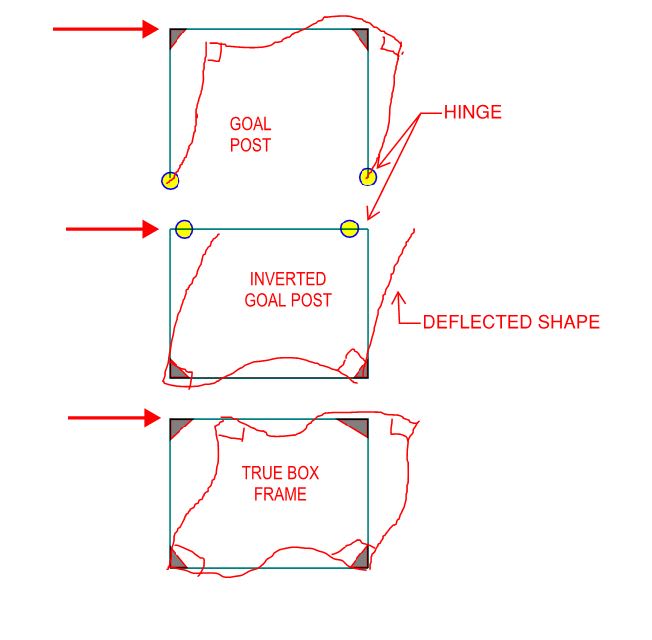sithlord382
Civil/Environmental
Hi,
Just posting to gain a better understanding of the applicability and analysis of rigid frames...
I am a project manager/ developer and I am typically coming across residential properties with proposed single storey wrap around or rear extensions, where the design involves demolishing the original rear wall of the house to create an 'open plan' ground floor. I recently came across a structural design where the engineer had designed a box frame, ie. high level beam, columns on either side and ground beam (encased in concrete, to take the weight of the structure above. When I asked why this was used instead of a goal post frame (the columns being bolted into pad foundations) he said it was because the box frame had also considered lateral stability. He kindly went on and explained to me that lateral stability is the consideration of a horizontal wind load acting on the structure and he had then justified the frame by treating the high level beam as simply supported, taking only vertical loads with pinned connections on either side, The columns were analysed to be fixed (at the column-ground beam connection) acting as cantilevers with only the lateral load being applied at the end of the column. With the high level beam being simply supported with pinned connections, the moment created by the vertical loads was only checked in the deflection of the specified beam as the moment was too high and impossible to create a moment connection. The column to ground beam junction is treated as fixed which is where the frame gets it rigidity.
Now with goal post frames, can the same principal as above not be applied to them? Can you not have a pinned support at high level and a fixed connection at low level where the column is fixed into the pad foundation?
How do you know when to use a box frame or a goal post frame? Does a goal post frame consider lateral stability?
From a project manager/ developers perspective I would always prefer to use a goal post frame purely as it is easier to construct as opposed to a box frame.
Any comments would be very much appreciated.
Thanks
S
Just posting to gain a better understanding of the applicability and analysis of rigid frames...
I am a project manager/ developer and I am typically coming across residential properties with proposed single storey wrap around or rear extensions, where the design involves demolishing the original rear wall of the house to create an 'open plan' ground floor. I recently came across a structural design where the engineer had designed a box frame, ie. high level beam, columns on either side and ground beam (encased in concrete, to take the weight of the structure above. When I asked why this was used instead of a goal post frame (the columns being bolted into pad foundations) he said it was because the box frame had also considered lateral stability. He kindly went on and explained to me that lateral stability is the consideration of a horizontal wind load acting on the structure and he had then justified the frame by treating the high level beam as simply supported, taking only vertical loads with pinned connections on either side, The columns were analysed to be fixed (at the column-ground beam connection) acting as cantilevers with only the lateral load being applied at the end of the column. With the high level beam being simply supported with pinned connections, the moment created by the vertical loads was only checked in the deflection of the specified beam as the moment was too high and impossible to create a moment connection. The column to ground beam junction is treated as fixed which is where the frame gets it rigidity.
Now with goal post frames, can the same principal as above not be applied to them? Can you not have a pinned support at high level and a fixed connection at low level where the column is fixed into the pad foundation?
How do you know when to use a box frame or a goal post frame? Does a goal post frame consider lateral stability?
From a project manager/ developers perspective I would always prefer to use a goal post frame purely as it is easier to construct as opposed to a box frame.
Any comments would be very much appreciated.
Thanks
S

